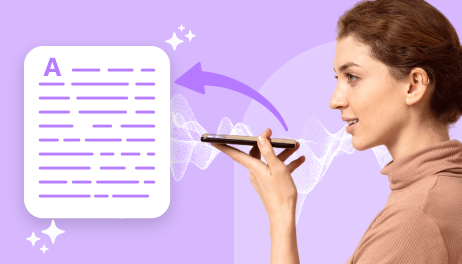Ever wished you could instantly translate your voice into English? Imagine meeting someone new while traveling or hopping on an international call and needing a quick way to break through the language barrier. With voice translation tech, that dream is real!
English is the most widely used language online, making up 25.3% of all online content. So, it’s no surprise that demand for English voice translation is surging.
So, what’s the best way to translate your voice into fluent English? Let’s dive in and discover how voice translation can make global communication easy, natural, and — best of all — instant!
How Voice Translation Works
Voice translation is a multi-step process that uses advanced AI technologies to transform spoken language into another—like English. Here’s a look at each stage of the process, from capturing your voice to producing an English translation:
1. Voice Recognition: Converting Speech to Text
Voice translation starts with Automatic Speech Recognition (ASR), which captures and converts spoken words into text. ASR systems are powered by machine learning models trained to recognize sounds and words accurately.
According to research, ASR systems can achieve over 90-95% accuracy when recognizing well-delivered speech, depending on the provided datasets.
2. Natural Language Processing (NLP): Understanding Context and Meaning
After the voice is transcribed into text, Natural Language Processing (NLP) is used to analyze the content.
NLP understands the meaning and context of words to deliver a more accurate translation. For instance, NLP models can distinguish between different meanings of words based on sentence context, making translations less literal and more meaningful.
3. Machine Translation: Translating Text to English
With the text now understood, Machine Translation (MT) systems convert it to English. Modern MT systems use neural networks trained on massive datasets to translate phrases and sentences based on context.
These systems are especially aimed at interpreting idiomatic phrases and culturally specific terms, which ultimately enhances the reliability of the English translation.
4. Text-to-Speech (TTS): Converting English Text into Spoken Words
In the final stage, Text-to-Speech (TTS) technology translates the English text back into spoken language. With advanced TTS, the translated English sounds natural and is delivered with an appropriate tone, making the experience more authentic for users.
Why These Technologies Matter
These technologies work together to provide a smooth and accurate voice translation experience. Each layer, from recognizing speech to refining context and translating tone, ensures the translated English reflects the original meaning, making communication across languages more effective than ever.
What Are the Best Methods to Translate Voice into English?
English is one of the most spoken languages worldwide and serves as the bridge for communication across diverse cultures. So, you need to use English, if you’re travelling, expanding your business or connecting with global audience through your message.
But if you’re a non-English speaker, translating your voice to English opens up countless opportunities. Understanding the various translation methods is essential to ensure clear communication. So, let’s explore:
1. Real-Time vs. Recorded Translation Options
You can choose between real-time translation and recorded translation, depending on your needs.
- Real-time translation allows you to translate speech instantly during conversations. For example, you’re in a conference, and your speaker is sharing ideas in different language, the translation tool help you understand everything happening in the moment.
- On the other hand, with recorded translation, you can capture audio and translate it at your own pace, ensuring accuracy. This method is great for translating speeches, lectures, or any audio that you can review later.
2. Voice-to-Text vs. Voice-to-Voice Translation
Next, let’s look at voice-to-text and voice-to-voice translation methods:
- Voice-to-text translation method turns spoken words into written texts. So, it’s usually perfect for taking notes during lectures or meetings.
- A voice-to-voice translation option converts your spoken language directly into another spoken language. For example, during travel, you can use voice-to-voice translation tools to communicate directly with locals.
3. Offline vs. Online Translation
Finally, let’s compare offline and online translation methods:
- Many translation apps work best with an internet connection. Tools like Wavel AI and Google Translate offer robust online features, allowing mobile access for quick and accurate translations. And, as of the first quarter of 2024, around 96% of global users access the internet via mobile phones.
- Conversely, offline translation is essential when you can’t access the internet. Devices like Pocketalk or certain apps allow you to translate speech without Wi-Fi. These tools ensure you can communicate even in places with poor connectivity.
Types of Voice Translation at a Glance
| Type | Description | Pros | Cons |
| Real-Time Translation | Instant translation during conversations | – Keeps conversations lively – Promotes engagement | – May require strong internet connection – Can be less accurate in noisy environments |
| Pre-Recorded Translation | Translation of previously recorded audio | – Allows for careful review – High accuracy in transcription | – Not suitable for spontaneous conversations – Takes more time to process |
| Text-Based Translation | Converts speech into written text | – Great for note-taking – Easy to review later | – Lacks the natural flow of conversation – Can be time-consuming to read |
| Voice-to-Voice Translation | Direct translation from one spoken language to another | – Maintains conversational flow – Feels personal and interactive | – May be less accurate in complex discussions – Requires both speakers to adapt to the tool |
| Online Translation | Translation tools that require internet access | – Up-to-date and accurate – Wide range of features | – Needs a reliable internet connection – May be limited in remote areas |
| Offline Translation | Translation tools that do not require internet | – Can be used anywhere – Reliable in remote settings | – May not have the latest updates – Limited features compared to online tools |
Top Voice Translation Apps and Tools for English Translation
With a variety of voice translation apps and tools available today, choosing the right one is essential to enhancing your communication experience. We’ve included five reliable options for English translation, along with their unique features.
1. Wavel AI
Wavel AI is an advanced voice translation tool specializing in voice-to-text and text-to-voice translations. Known for its accuracy, it’s ideal for content creators, businesses, and personal use.
Top Features:
- Supports over 100 languages with high accuracy.
- Converts voice to natural-sounding English text and vice versa.
- 260 plus cloning voices
- Real-time translation and smart customization option.
2. Notta
Notta is a powerful voice translation tool that focuses on real-time transcription and translation services. It is designed for both personal and professional use, making it ideal for students, travelers, and business meetings where quick communication is essential.
Top Features:
- Instant translation for fluid conversations.
- Automatically transcribes spoken words into text.
- Supports a wide range of languages.
- Accessible on iOS and Android devices.
3. DeepL Translator
DeepL is widely recognized for its high accuracy and nuanced language translations, especially between English and European languages. It’s popular among professionals needing precise, context-aware translations.
Top Features:
- Offers translations in 30+ languages with superior contextual accuracy.
- Supports voice input and high-quality voice synthesis for spoken translations.
- Provides a dictionary with alternate translation options to refine the result.
- Integrates with apps like Microsoft Word for seamless editing.
4. iTranslate Voice
iTranslate Voice allows users to translate their voice into various languages, including English, instantly. It’s popular among travelers and business professionals for its easy-to-use interface.
Top Features:
- Instant voice-to-voice translation in over 40 languages.
- Custom phrasebook for saving frequently used translations.
- Ability to switch seamlessly between languages in a conversation.
- Offline translation is available for popular languages.
What Makes a Good Voice Translation Tool?
When choosing a perfect voice translation tool, several key features should be considered for a better experience. So, look at the essentials below to find the best translation tool to reach the global market.
- Accuracy of Translation
A good voice translation tool delivers precise translations, understanding various accents and dialects. This level of precision ensures that your message gets across without misunderstandings.
- Speed of Translation
Timing matters in live conversations. The best tools provide real-time translations with minimal delays. Some high-quality tools can translate speech within one second, making interactions smooth and natural.
- User-Friendly Interface
A great voice translation tool has an intuitive design, making it easy for anyone to use. Simple navigation and clear instructions empower users, regardless of their tech skills.
- Support for Multiple Languages
Versatility is crucial. A top-notch voice translation tool should support a wide range of languages—many offer translations for over 100 languages. This capability allows you to effortlessly connect with people from various backgrounds.
- Voice Quality and Clarity
The clarity of the translated voice significantly impacts communication. Quality voice translation tools produce natural-sounding speech. Also, high-quality text-to-speech (TTS) voices are often indistinguishable from human voices.
- Privacy and Security
Finally, ensure that your tool prioritizes your privacy. Look for strong data protection policies, such as encryption and clear consent practices regarding your recordings. This way, you can communicate freely with the confirmation of secured data.
Speak Freely: Translate Your Voice Effortlessly!
Translating your voice into English opens up new doors to connect with others worldwide, whether for work, travel, or just everyday conversations. With intuitive, real-time solutions, you can speak naturally and confidently wherever you go.
So, are you ready to transform your voice into English? Let Wavel AI empower your English translation journey, and start speaking confidently in English. Try it for free now!
FAQs
1. Are voice translation apps accurate?
Voice translation apps are generally accurate, though they may have difficulty with heavy accents or complex sentences. Apps like Wavel AI offer higher accuracy for smoother translations.
2. Can I translate my voice to English while speaking with someone?
Yes, real-time voice translation allows you to speak naturally with someone and instantly translate your words into English, helping you communicate more effectively without delays.
3. Is voice translation safe to use?
Trusted apps like Wavel AI and Google Translate are generally safe to use. However, you should always check your privacy settings to protect sensitive information when using voice translation tools.
4. How much does voice translation cost?
Many voice translators are free, but some advanced tools or premium features may have costs. Wavel AI, for example, offers both free and paid options with added features for higher accuracy.


.webp)






